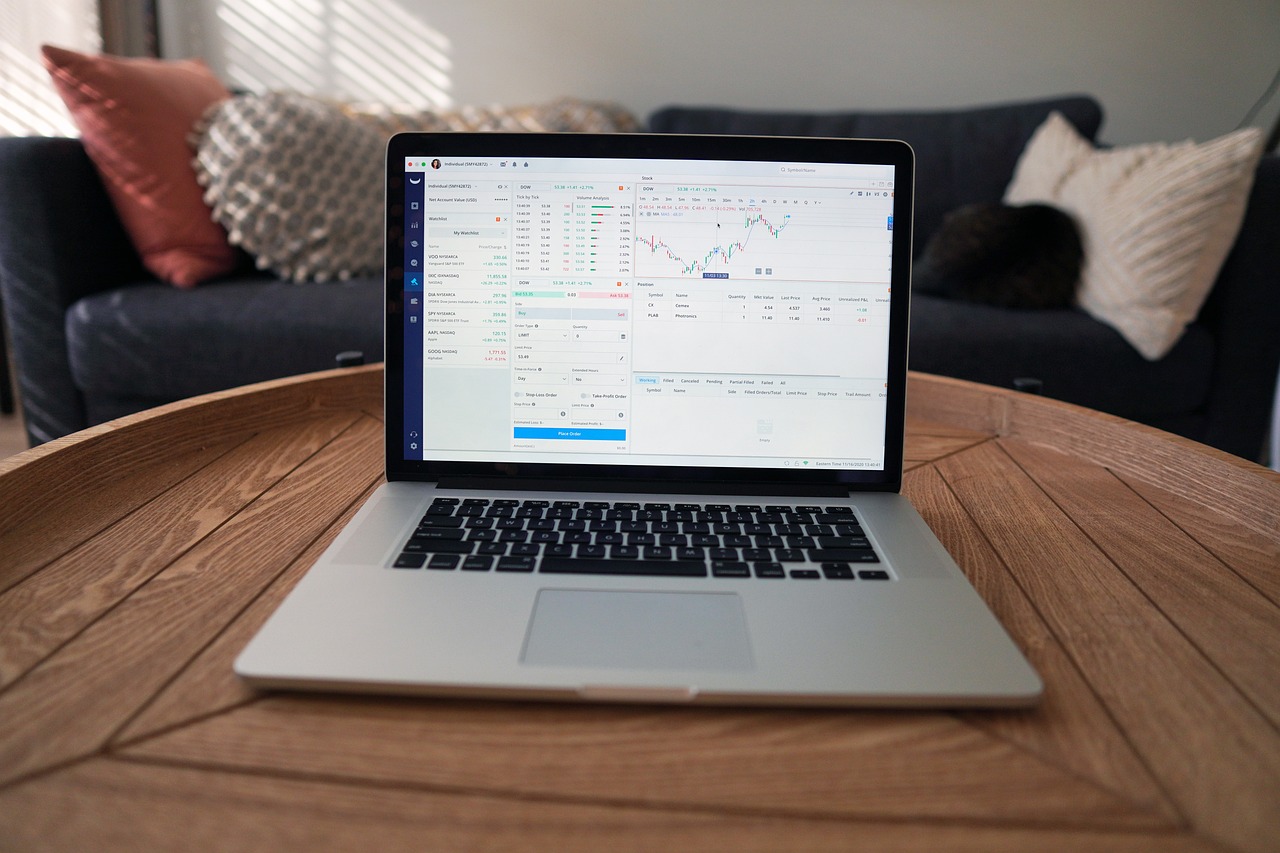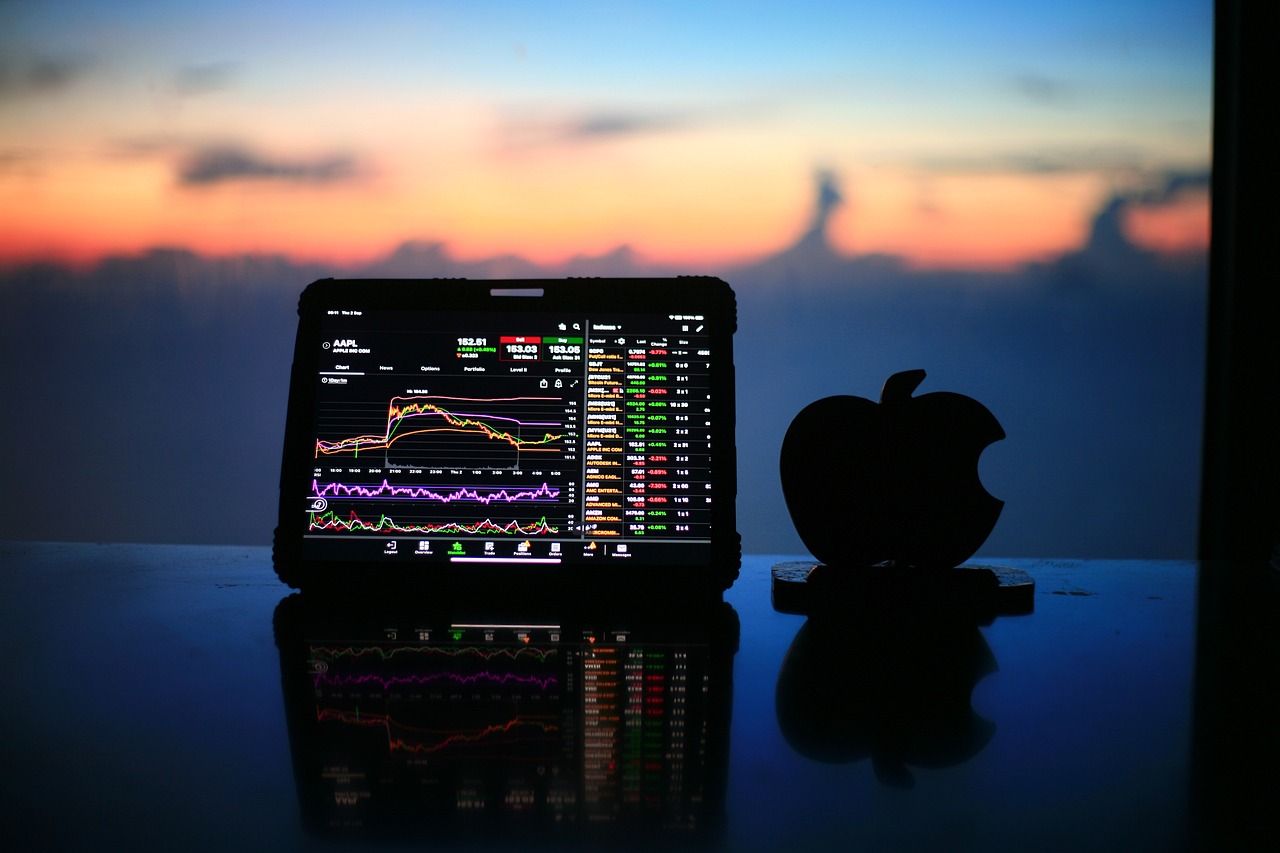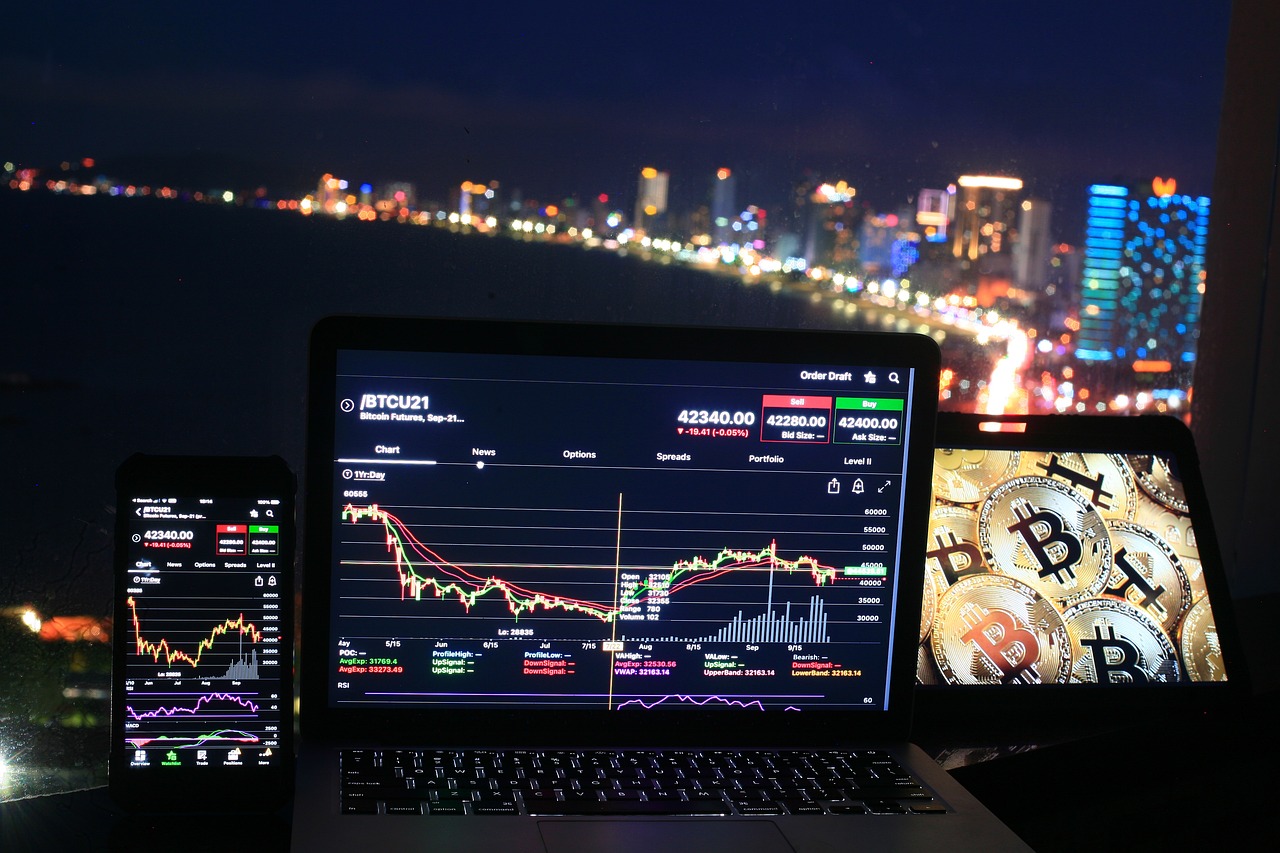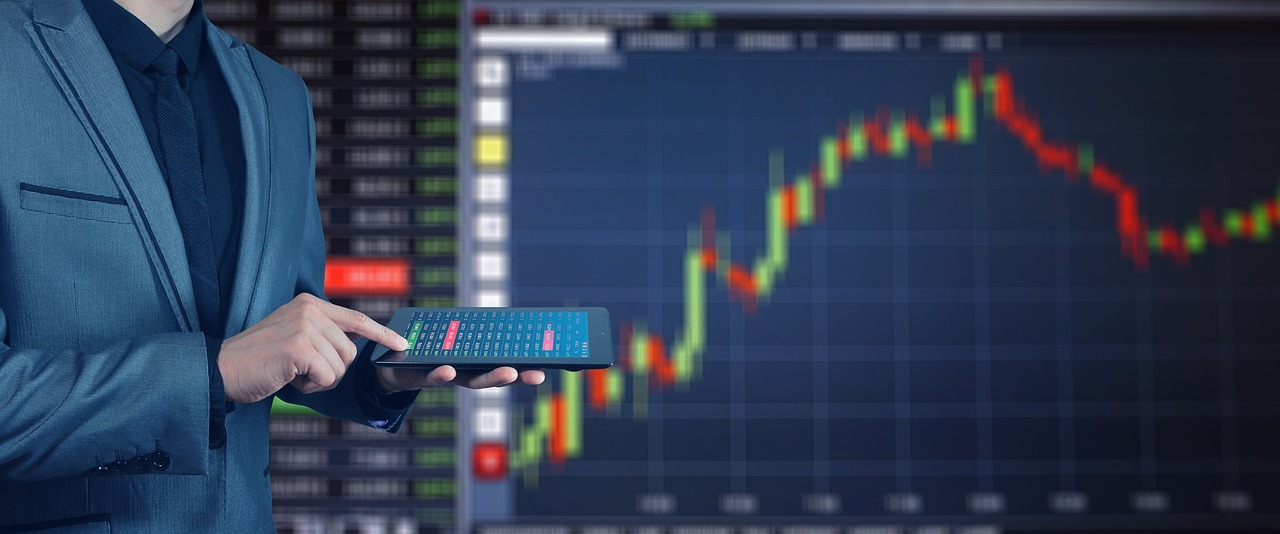How to Leverage Margin Trading Safely
Margin trading can be an exhilarating way to amplify your investment potential, but it also comes with its fair share of risks. Imagine you're standing at the edge of a cliff, peering down into a vast valley of opportunities. That’s what margin trading feels like—it’s thrilling, but one misstep can lead to a steep fall. In this article, we’ll explore how to navigate the exciting yet precarious world of margin trading safely. By understanding the mechanics, benefits, and risks involved, you can equip yourself with the knowledge needed to make informed decisions and maximize your trading potential.
Margin trading allows investors to borrow funds from a broker to trade larger positions than their actual capital would permit. This means you can control a greater amount of assets without having to put down the full purchase price. However, while this can lead to increased profits, it can also amplify losses, making it crucial to fully grasp how margin trading works. Think of it like using a credit card—it's great for making big purchases, but if you don’t pay it back, the debt can pile up quickly.
One of the most appealing aspects of margin trading is the potential for enhanced returns. By leveraging borrowed funds, you can take advantage of market movements that you might miss if you were only using your own capital. Here are some key advantages:
With margin trading, your buying power expands significantly. This means you can seize opportunities in the market that may otherwise be out of reach. For instance, if you have $1,000 in your trading account and your broker offers a 2:1 margin, you could control up to $2,000 worth of assets. This increased leverage can lead to substantial gains, but remember, it can also lead to significant losses if the market moves against you.
Margin trading promotes capital efficiency. Instead of tying up all your funds in a single trade, you can open larger positions while keeping some capital available for other opportunities. This strategy allows you to diversify your investments without needing to commit all your resources upfront. Just like a chef who uses a pinch of salt to enhance the flavor of a dish, margin trading can help you make the most of your available capital.
By leveraging borrowed funds, traders have the potential to achieve higher returns on their investments. For example, if you invest $1,000 of your own money and make a 10% profit, you earn $100. However, if you use margin to control $2,000, a 10% profit nets you $200. This potential for greater rewards makes margin trading an attractive option, especially for those willing to navigate the associated risks.
While the allure of margin trading is strong, it’s essential to recognize the risks involved. One of the most significant dangers is the possibility of losing more than your initial investment. If the market moves unfavorably, you could find yourself in a precarious position, owing money to your broker. Understanding these risks is vital for responsible trading. Here are some common risks:
- Increased volatility: Margin trading can lead to more significant fluctuations in your account balance.
- Margin calls: If your account equity falls below a certain level, your broker may require you to deposit more funds.
- Emotional decision-making: The pressure of trading on margin can lead to impulsive decisions that may not align with your trading strategy.
Implementing best practices can significantly mitigate the risks associated with margin trading. Establishing a clear risk management plan is vital. This includes setting stop-loss orders to automatically sell assets if they fall below a specific price, helping protect your capital from significant losses. Additionally, choosing the right broker is crucial. Look for brokers that offer transparent fees, reasonable margin requirements, and robust customer support.
Staying informed about market conditions is essential for margin traders. Keep an eye on economic indicators and market trends to make informed trading decisions. This proactive approach can help you anticipate market movements and adjust your trading strategies accordingly. Remember, knowledge is power, and in the fast-paced world of trading, being well-informed can be the difference between profit and loss.
Q: What is margin trading?
A: Margin trading allows investors to borrow funds from a broker to trade larger positions than they could with their own capital.
Q: What are the risks of margin trading?
A: Risks include the potential for significant losses, margin calls, and increased emotional stress while trading.
Q: How can I manage risks in margin trading?
A: Implement a risk management plan, set stop-loss orders, and choose a reputable broker to mitigate risks.
Q: Is margin trading suitable for everyone?
A: Margin trading is not suitable for everyone, especially those who are risk-averse or new to trading. It requires a solid understanding of the market and effective risk management strategies.

Understanding Margin Trading
Margin trading is like stepping onto a high-wire without a safety net—thrilling yet perilous. It allows investors to borrow funds to trade larger positions than they could with their own capital alone. Imagine you have $1,000 in your trading account, but with margin trading, you might be able to control a position worth $5,000 or even $10,000. This kind of leverage can amplify your profits, but it can also magnify your losses. If the market moves against you, you could end up losing more than your initial investment. That's why understanding the mechanics of margin trading is crucial for responsible trading.
The basic principle behind margin trading is straightforward: you deposit a certain amount of money, known as the margin, and then you borrow additional funds from your broker to increase your buying power. This borrowed money is typically a percentage of the total value of the trade, known as the margin requirement. For instance, if a broker offers a 50% margin requirement, you would need to deposit $500 to trade $1,000 worth of assets.
However, it's not all rainbows and butterflies. The concept of margin calls looms large in this trading style. If your account's equity falls below a certain threshold due to market fluctuations, your broker may issue a margin call, requiring you to deposit more funds or sell some of your assets to cover the losses. This is where many traders find themselves in hot water, as the pressure to act quickly can lead to rash decisions.
To navigate the complexities of margin trading safely, it's essential to have a solid grasp of both the mechanics and the risks involved. Understanding how leverage works and the potential for both high rewards and significant losses can help you make informed decisions. Ultimately, the goal is to leverage margin trading as a tool to amplify your trading strategy while minimizing the risks. So, buckle up and prepare to dive deep into the world of margin trading—it's a thrilling ride, but one that requires caution and strategy!

Benefits of Margin Trading
Margin trading is like getting a financial booster shot—it can elevate your trading game to new heights! By allowing investors to borrow funds, margin trading enables them to control larger positions than they could with their own capital alone. This means that even a small investment can yield significant returns, provided the market moves in your favor. But what exactly are the benefits of this powerful trading strategy? Let’s dive in!
One of the most compelling advantages of margin trading is the increased buying power. Imagine you have $1,000 in your trading account. With margin trading, you might be able to control $5,000 worth of assets, depending on the margin requirement set by your broker. This means you can seize market opportunities that may have been out of reach otherwise. For instance, if you spot a promising stock that’s poised for growth, margin trading gives you the flexibility to invest more than you would typically be able to, amplifying your potential gains.
With margin trading, investors can access greater buying power, enabling them to take advantage of market opportunities they might otherwise miss. This increased leverage can lead to significant gains. However, it’s essential to remember that while leverage can magnify profits, it can also amplify losses. Therefore, it’s crucial to approach margin trading with caution and strategy.
Another significant benefit of margin trading is capital efficiency. Instead of putting all your money into a single investment, you can use margin to diversify your portfolio. This means you can spread your capital across multiple assets, reducing the risk associated with putting all your eggs in one basket. For example, if you have $10,000 and use margin to control $30,000 worth of assets, you can invest in various stocks, bonds, or other financial instruments without tying up all your cash. This flexibility allows you to optimize your investment strategies and potentially enhance your returns.
By leveraging borrowed funds, traders can potentially achieve higher returns on their investments. This is particularly appealing for those who are willing to accept the associated risks. For instance, if you invest $1,000 of your own money and use margin to control $5,000, a 10% increase in the asset's value would yield a $500 profit instead of just $100. This higher return potential is what draws many investors to margin trading, but it’s essential to weigh this against the risks involved.
In summary, margin trading offers several benefits that can enhance your trading experience and potentially increase your profits. From increased buying power and capital efficiency to the opportunity for higher returns, it’s a strategy worth considering. However, it’s crucial to approach margin trading with a well-thought-out plan to mitigate the risks involved. As with any investment strategy, knowledge is power—so make sure you understand the ins and outs of margin trading before diving in!
- What is margin trading? Margin trading involves borrowing funds from a broker to trade larger positions than your own capital would allow.
- What are the risks of margin trading? The primary risks include the potential to lose more than your initial investment and the possibility of a margin call, where you must deposit more funds to maintain your position.
- How can I manage risks in margin trading? Implementing a risk management plan, such as setting stop-loss orders and defining acceptable loss limits, can help protect your capital.
- Can anyone do margin trading? While many brokers offer margin trading, it typically requires a margin account and may have specific eligibility criteria.

Increased Buying Power
Margin trading is like having a superpower in the world of investing. Imagine being able to control a much larger position in the market without needing to have all the cash upfront. This is precisely what increased buying power through margin trading offers. By borrowing funds from a broker, traders can amplify their purchasing capabilities, allowing them to seize opportunities that may have otherwise slipped through their fingers. For instance, if you have $1,000 in your trading account and your broker offers a 2:1 margin, you could potentially control up to $2,000 worth of assets. This means you can make larger trades and potentially see greater returns on your investments.
However, while this increased buying power can lead to significant profits, it’s essential to remember that it also comes with increased risk. Just as a superhero must learn to wield their powers responsibly, traders must approach margin trading with caution. The potential for higher profits is enticing, but it’s vital to have a solid understanding of the market and a well-thought-out strategy. In essence, margin trading allows for a more dynamic approach to investing, enabling traders to capitalize on market movements that require quick decision-making and execution.
To further illustrate the concept, let’s consider a simple example. Suppose you’re eyeing a stock that’s priced at $100. With your $1,000 and a 2:1 margin, you can buy 20 shares instead of just 10. If the stock price rises to $120, your investment would be worth $2,400, giving you a profit of $400 after accounting for the borrowed funds. On the flip side, if the stock price drops to $80, your losses would also be magnified, and you could find yourself in a precarious financial situation. Therefore, understanding how to effectively leverage this increased buying power is crucial for any trader looking to navigate the exciting yet volatile waters of margin trading.
In conclusion, while margin trading can significantly enhance your buying power, it’s imperative to proceed with caution. Ensuring that you have a comprehensive risk management strategy in place will help protect your investments and allow you to take full advantage of the opportunities that margin trading presents. Always remember, with great power comes great responsibility!

Capital Efficiency
When it comes to trading, is a game-changer. Imagine you have a limited amount of money to invest, but you want to make the most out of every dollar. This is where margin trading shines. By allowing traders to borrow funds, margin trading enables them to open larger positions without needing to have the full amount upfront. It's like having a powerful magnifying glass that helps you see opportunities that would otherwise be too far out of reach.
For instance, let’s say you have $1,000 to invest. Without margin, you can only buy stocks worth that amount. However, with a margin account, you might be able to control a position worth $5,000 or even more, depending on the leverage offered by your broker. This means you can capitalize on market movements that could lead to significant profits. However, this increased buying power comes with its own set of challenges.
Using margin effectively requires a deep understanding of how to manage your capital. Here are some key points to consider:
- Maximize Your Opportunities: By leveraging borrowed funds, you can seize market opportunities that might not be available with your own capital alone.
- Optimize Your Investment Strategy: Margin trading allows you to diversify your portfolio more effectively, spreading your capital across various investments.
- Enhance Potential Returns: With the ability to control larger positions, your potential returns can increase significantly, which is appealing to many traders.
However, it's essential to remember that while margin trading can enhance capital efficiency, it also amplifies risks. If the market moves against you, losses can exceed your initial investment. This is why a well-thought-out strategy and risk management plan are crucial. Just like a tightrope walker who needs to maintain balance, margin traders must navigate their investments carefully to avoid falling into the abyss of excessive losses.
In conclusion, capital efficiency through margin trading can be a powerful tool for savvy investors. By understanding how to use margin wisely, you can stretch your capital further and potentially reap greater rewards. But always keep in mind the importance of risk management to ensure that your trading journey remains on solid ground.

Opportunity for Higher Returns
When it comes to trading, the allure of higher returns is undeniable. Margin trading opens the door to this enticing possibility by allowing traders to leverage borrowed funds. Imagine this scenario: you have $1,000 in your trading account, and through margin trading, you can control a position worth $5,000. This means that even a modest price movement can yield substantial profits. For instance, if your investment appreciates by just 10%, you would see a return of $500 instead of the $100 you would have made without margin. However, while the potential for increased returns is exciting, it’s essential to remember that it also magnifies the risk of losses.
One of the key factors contributing to higher returns in margin trading is the concept of leverage. Leverage allows traders to amplify their exposure to a particular asset without needing to invest the full amount upfront. This means you can seize opportunities in the market that require more capital than you currently have. For example, if you’re trading stocks, and you believe a certain company is poised for growth, using margin can enable you to buy more shares than you could with your own funds alone. However, this strategy should be approached with caution and a solid understanding of the market dynamics at play.
It's crucial to conduct thorough research before diving into margin trading. Understanding the underlying asset, market trends, and economic indicators can significantly enhance your potential for success. Here are a few tips to keep in mind:
- Research Market Trends: Stay updated on market movements and economic news that can affect asset prices.
- Set Realistic Goals: Aim for achievable returns and avoid setting your expectations too high.
- Diversify Your Investments: Don’t put all your eggs in one basket; spread your investments across different assets to mitigate risk.
In summary, while margin trading presents an attractive opportunity for higher returns, it’s essential to balance ambition with caution. The thrill of potentially larger profits can be enticing, but it’s vital to implement sound trading strategies and maintain a disciplined approach. By doing so, traders can maximize their chances of reaping the rewards while minimizing the risks associated with margin trading.
Q1: What is margin trading?
Margin trading involves borrowing funds from a broker to trade larger positions than your current capital allows. This can amplify both potential profits and losses.
Q2: How does leverage work in margin trading?
Leverage allows traders to control a larger position with a smaller amount of capital. For example, a 5:1 leverage means you can control $5,000 with just $1,000 of your own money.
Q3: What are the risks associated with margin trading?
The primary risks include the potential for significant losses, which can exceed your initial investment, and the possibility of a margin call, requiring you to deposit more funds to maintain your positions.
Q4: How can I trade safely using margin?
Implementing a solid risk management plan, choosing a reputable broker, and staying informed about market conditions are crucial for safe margin trading.

Risks Involved in Margin Trading
Margin trading can be an electrifying way to boost your investment potential, but it's not without its fair share of risks. When you borrow money to trade, you're essentially playing with fire. If the market moves against you, the consequences can be severe. One of the most significant risks is the possibility of losing more than your initial investment. Unlike traditional trading where you only risk your capital, margin trading can lead to a situation where you owe more than you put in. This is particularly true in volatile markets where price swings can happen in the blink of an eye.
Another critical risk to consider is the margin call. This occurs when the equity in your account falls below the broker's required minimum. If your account value dips too low, your broker may demand that you deposit more funds or sell off some of your assets to cover the losses. Imagine being forced to sell your investments at a loss just to meet a margin requirement—it's a nightmare scenario for any trader.
Additionally, margin trading can lead to emotional strain. The pressure of managing leveraged positions can make even seasoned traders second-guess their strategies. When you're on edge, it’s easy to make impulsive decisions that can further jeopardize your investments. The psychological aspect of trading is often overlooked, but it's crucial to maintain a clear mind and stick to your trading plan.
To give you a clearer picture of the risks involved, here’s a brief overview:
| Risk Type | Description |
|---|---|
| Loss of Capital | Potential to lose more than your initial investment due to borrowed funds. |
| Margin Calls | Broker demands additional funds or liquidation of assets when account equity falls below a certain level. |
| Emotional Stress | Increased pressure can lead to poor decision-making and impulsive trades. |
In summary, while margin trading can amplify your gains, it can also magnify your losses. It's essential to approach this trading style with caution and a well-thought-out strategy. Understanding these risks is the first step toward responsible trading. Remember, the thrill of margin trading should never overshadow the importance of safeguarding your investments.
- What is margin trading? Margin trading involves borrowing funds to trade larger positions than what your capital alone would allow.
- What are the benefits of margin trading? It increases buying power and allows for higher potential returns, enabling traders to capitalize on market opportunities.
- How can I manage risks in margin trading? Implement a solid risk management plan, set stop-loss orders, and choose a reputable broker to help mitigate risks.
- What should I consider when choosing a broker for margin trading? Look for factors like fees, margin requirements, customer support, and the broker's reputation in the market.

Best Practices for Safe Margin Trading
When it comes to margin trading, safety should always be your top priority. The thrill of potentially high returns can be intoxicating, but without a solid strategy, that excitement can quickly turn into a nightmare. One of the most effective ways to safeguard your investments is by establishing a clear risk management plan. This plan should outline your trading goals and set specific guidelines for how much you are willing to risk on each trade. For instance, you might decide that you will never risk more than 2% of your trading capital on a single position. By adhering to this rule, you can minimize the impact of any single loss on your overall portfolio.
Another essential practice is to set stop-loss orders. A stop-loss order is a predetermined price at which you will exit a losing trade to prevent further losses. Think of it as your safety net—when the market takes a downturn, your stop-loss order can help you avoid catastrophic losses. However, it’s important to place these orders wisely. If you set them too close to your entry point, you might find yourself getting stopped out frequently due to normal market fluctuations. On the other hand, setting them too far away could expose you to larger losses than you can handle.
Choosing the right broker is another critical factor in safe margin trading. Not all brokers are created equal, and the differences can significantly impact your trading experience. When selecting a broker, consider factors such as fees, margin requirements, and customer support. A broker with high fees can eat into your profits, while one with low margin requirements might encourage you to take on more risk than you should. Additionally, having responsive customer support can make a world of difference when you encounter issues or have questions. Always do your homework and read reviews to ensure that you’re partnering with a reputable broker.
Moreover, it's essential to monitor market conditions regularly. The financial markets are dynamic, and what worked yesterday may not work today. Keeping an eye on economic indicators and market trends can help you make informed decisions. For instance, if you notice that a particular sector is experiencing volatility due to economic news, you may want to adjust your trading strategy accordingly. Staying informed can be the difference between making a profit and incurring a loss.
Lastly, consider diversifying your investments. While margin trading allows you to amplify your returns, it can also amplify your losses. By spreading your investments across different assets or sectors, you can reduce the risk associated with any single trade. Diversification acts as a buffer, helping to protect your portfolio from significant downturns in specific areas.
In summary, safe margin trading is all about preparation and strategy. By establishing a risk management plan, setting stop-loss orders, choosing the right broker, monitoring market conditions, and diversifying your investments, you can enjoy the benefits of margin trading while minimizing potential risks. Remember, the goal is to maximize your potential without jeopardizing your hard-earned capital.
- What is margin trading? Margin trading involves borrowing funds to trade larger positions than what your capital would normally allow, which can amplify both profits and losses.
- How can I manage risks in margin trading? You can manage risks by setting a risk management plan, using stop-loss orders, and diversifying your investments.
- Is margin trading suitable for everyone? Margin trading is not suitable for everyone, especially those who cannot afford to lose their investment. It requires a sound understanding of the market and risk management strategies.
- What should I look for in a broker for margin trading? Look for a broker with low fees, reasonable margin requirements, strong customer support, and a good reputation.

Setting a Risk Management Plan
When it comes to margin trading, having a solid risk management plan is not just a good idea; it's absolutely essential. Think of it as your safety net in a high-wire act. Without it, one misstep could lead to a disastrous fall. A well-crafted risk management plan helps you navigate the volatile waters of margin trading, ensuring you stay afloat even when the market gets choppy.
First things first, you need to define your risk tolerance. This is the amount of risk you are willing to accept in your trading activities. Everyone has a different comfort level, so take the time to assess your financial situation and emotional resilience. Are you the type who can handle a rollercoaster ride, or do you prefer a gentle stroll? Knowing your limits will guide your trading decisions.
Next, consider implementing stop-loss orders. These are like your trading safety valves, automatically selling a security when it reaches a predetermined price. For instance, if you buy a stock at $100 and set a stop-loss at $90, your investment will automatically sell if it drops to that level. This helps you cap your losses and prevents emotional decision-making during market downturns. It’s like having a parachute—if you fall, you want to slow down your descent!
Moreover, it's crucial to set acceptable loss limits for each trade. This means deciding how much of your capital you are willing to risk on a single trade. A common guideline is to risk no more than 1% to 2% of your total trading capital on any one trade. For example, if you have a trading account with $10,000, you should avoid losing more than $100 to $200 on a single position. This approach helps ensure that a few bad trades won’t wipe out your entire account.
Another key component of your risk management plan should include regularly reviewing and adjusting your strategies. The markets are dynamic, and what works today might not work tomorrow. Keep an eye on your performance and be willing to adapt your plan as necessary. This might involve analyzing your trades to identify patterns in your successes and failures. After all, even the best pilots review their flight logs to improve their skills!
In summary, setting a risk management plan is about creating a framework that allows you to trade confidently while minimizing potential losses. By defining your risk tolerance, using stop-loss orders, setting acceptable loss limits, and regularly reviewing your strategies, you can navigate the world of margin trading with greater assurance. Remember, the goal is not just to make profits but to protect your capital so you can trade another day!
- What is a stop-loss order? A stop-loss order is an instruction to sell a security when it reaches a certain price, helping to limit potential losses.
- How much capital should I risk on a trade? It's generally advised to risk no more than 1% to 2% of your total trading capital on a single trade.
- Why is risk management important in margin trading? Risk management helps protect your capital and ensures that a few bad trades do not lead to significant financial losses.

Choosing the Right Broker
When it comes to margin trading, choosing the right broker can be the difference between success and disaster. It’s like picking a partner for a dance; you want someone who knows the steps and can guide you smoothly through the rhythm of the market. But how do you find that perfect match? There are several key factors to consider that can help you make an informed decision.
First and foremost, you need to look at the fees. Different brokers have different fee structures, and these can significantly impact your overall profitability. Some brokers charge a flat fee per trade, while others may have a percentage-based fee or a combination of both. Understanding these costs is crucial, as high fees can eat into your margins, especially if you’re trading frequently. So, do your homework and compare the fee structures of various brokers to find one that aligns with your trading style.
Next, consider the margin requirements. Different brokers have varying requirements for how much margin you need to maintain your positions. A broker with lower margin requirements might seem appealing because it allows you to leverage your capital more aggressively. However, it’s essential to balance this with the broker's stability and reputation. A broker that offers too-good-to-be-true terms may be a red flag, so always prioritize reliability over high leverage.
Another critical aspect is customer support. In the fast-paced world of trading, having access to responsive and knowledgeable customer support can make a world of difference. Imagine having a technical issue or a question about your margin account during a crucial trading moment. You’d want to reach someone who can help you quickly! Check reviews and ratings to gauge the quality of customer service offered by potential brokers.
Additionally, trading platforms can vary widely among brokers, and the right platform can enhance your trading experience. Look for a broker that provides a user-friendly interface, advanced charting tools, and real-time data. A robust trading platform can help you make quick and informed decisions, which is especially important in margin trading where every second counts.
Lastly, always check for regulatory compliance. Ensure that the broker you choose is regulated by a reputable financial authority. This not only adds a layer of security to your funds but also ensures that the broker adheres to industry standards. Trading with an unregulated broker can expose you to unnecessary risks, so it's best to play it safe.
In summary, selecting the right broker for margin trading involves careful consideration of fees, margin requirements, customer support, trading platforms, and regulatory compliance. By taking the time to evaluate these factors, you can find a broker that not only meets your trading needs but also enhances your overall trading experience. Remember, in the world of margin trading, the right broker is your ally, guiding you through the highs and lows of the market.
- What is margin trading? Margin trading allows traders to borrow funds to increase their purchasing power, enabling them to control larger positions in the market.
- What are the risks of margin trading? The primary risks include the potential to lose more than your initial investment and the possibility of a margin call if your equity falls below the required level.
- How can I manage risks in margin trading? Establishing a solid risk management plan, setting stop-loss orders, and only using a portion of your capital for margin trades can help mitigate risks.
- What should I look for in a margin trading broker? Look for competitive fees, favorable margin requirements, excellent customer support, a robust trading platform, and regulatory compliance.

Monitoring Market Conditions
When it comes to margin trading, keeping a close eye on market conditions is not just a good idea; it's a necessity. Imagine trying to navigate a stormy sea without checking the weather forecast. You wouldn't want to set sail without knowing if a storm is brewing, right? Similarly, in the world of trading, being aware of economic indicators and market trends can make the difference between a profitable trade and a costly mistake.
Understanding market conditions means you're not just reacting to price movements; you're anticipating them. Factors such as economic reports, interest rates, and geopolitical events can all influence market volatility. For instance, a sudden change in interest rates can lead to significant fluctuations in currency values, which can impact your margin positions. Therefore, staying informed is key.
One effective way to monitor market conditions is by following a variety of economic indicators. These indicators can provide insights into the overall health of the economy and potential market movements. Here are some important indicators to keep an eye on:
- Gross Domestic Product (GDP): A measure of economic activity, indicating how well the economy is performing.
- Unemployment Rates: High unemployment can signal economic trouble, affecting consumer spending and market performance.
- Consumer Price Index (CPI): This measures inflation and can influence central bank policies.
- Central Bank Announcements: Changes in monetary policy can lead to market shifts.
Additionally, utilizing technical analysis can also help traders make informed decisions. By analyzing price charts and patterns, traders can identify trends and potential reversal points. Tools like moving averages, Bollinger Bands, and Relative Strength Index (RSI) can provide valuable insights into market momentum. However, it's essential to remember that technical analysis is not foolproof; it should be used in conjunction with fundamental analysis for a well-rounded approach.
Moreover, engaging with financial news platforms, subscribing to market analysis reports, and participating in trading forums can provide real-time updates and diverse perspectives on market conditions. Networking with other traders can also enhance your understanding of market dynamics, as sharing experiences and strategies can lead to better decision-making.
In conclusion, monitoring market conditions is an ongoing process that requires diligence and adaptability. By staying informed about economic indicators, utilizing technical analysis, and engaging with the trading community, you can navigate the complexities of margin trading more effectively. After all, in the fast-paced world of trading, knowledge is not just power; it's your lifeline.
Q: What are the key economic indicators to watch for margin trading?
A: Key indicators include GDP, unemployment rates, CPI, and central bank announcements, as these can significantly affect market conditions.
Q: How can I use technical analysis in margin trading?
A: Technical analysis involves analyzing price charts and patterns to identify trends and potential reversal points, using tools like moving averages and RSI.
Q: Why is it important to stay informed about market conditions?
A: Staying informed allows traders to anticipate market movements and make informed decisions, reducing the risk of significant losses.
Frequently Asked Questions
- What is margin trading?
Margin trading is a practice that allows traders to borrow funds from a broker to trade larger positions than they could with their own capital alone. This can amplify both potential profits and losses, making it a high-risk, high-reward strategy.
- How does margin trading increase buying power?
By using margin, traders can control larger amounts of assets without having to pay the full price upfront. For example, if a trader has $1,000 and uses a 2:1 margin, they can trade up to $2,000 worth of assets, thus increasing their buying power significantly.
- What are the risks associated with margin trading?
Margin trading can be risky because it increases the potential for losses. Traders may end up losing more than their initial investment if the market moves against them. Additionally, if the value of the assets falls below a certain level, traders might face a margin call, requiring them to deposit more funds or liquidate positions.
- How can I manage risks while margin trading?
To manage risks effectively, it's essential to establish a risk management plan. This includes setting stop-loss orders, defining acceptable loss limits, and not over-leveraging your positions. Diversifying your investments can also help mitigate risks.
- What should I consider when choosing a broker for margin trading?
When selecting a broker, consider factors such as their reputation, fees, margin requirements, and the quality of customer support. It’s crucial to choose a broker that aligns with your trading style and offers the tools you need to succeed.
- How important is it to monitor market conditions in margin trading?
Monitoring market conditions is extremely important in margin trading. Staying informed about economic indicators and market trends helps traders make timely and informed decisions, ultimately protecting their investments and maximizing potential returns.



















